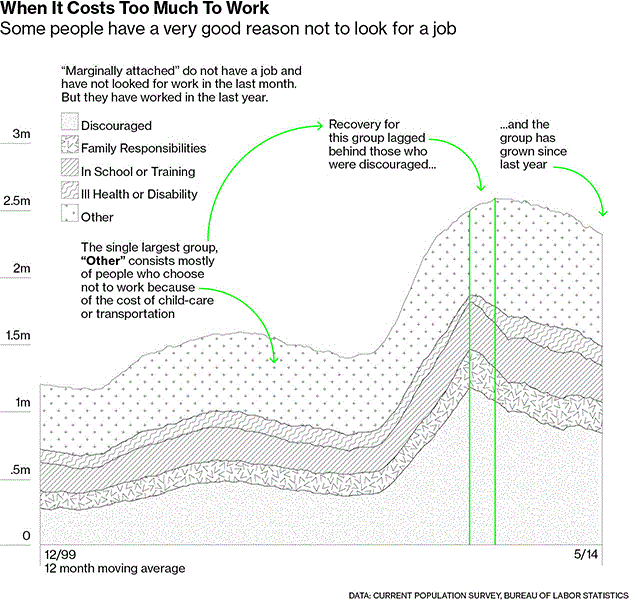Childcare and Other Costs: Why Workers Stop Working
There are fewer discouraged people in the U.S. This time last year there were
780,000 of them, according to the Bureau of Labor and Statistics. Now there
are
only 697,000. This is good news. The way the bureau defines them,
gdiscouragedh people havenft looked for work in the last month because they
donft think a job is available to match their age, experience, or training.
The discouraged are only one part of a larger group—what economists call the
gmarginally attached.h These are people who have worked in the last year but not
looked for work in the last month. The discouraged total slightly less than half
of this larger group. The rest havenft looked for work for other reasons. Small
numbers of them are sick, have family to take care of, or have returned to
school.

Then therefs a category—also slightly less than half of the marginally
attached: other. That number has risen since last year, from 684,000 to 728,000.
Last week, Dave Altig, head of research for the Atlanta Federal Reserve, wrote a
blog
post pointing out two things: First, many people confuse discouraged workers
with the rest of the marginally attached. Second, that may not matter. All the
people whofve had a job this year but havenft looked recently tend to move back
into the workforce at the same rate, whether theyfre discouraged or not.
Altig, in his position at the Atlanta Fed, is thinking about things that
monetary policy can change. Central banks wield blunt instruments that can
have an effect only on broad populations. hWefre trying to distinguish
those things that we think monetary policy might react to,h he says, gand those
things that are outside of our portfolio.h So if two groups of people who
want to work—hdiscouragedh and gotherh—follow the same broad trend, a central
bank can treat them as synonymous. Janet Yellen hinted at this in her March
press conference, when she said that she gof courseh watches discouraged
and marginally attached workers.
But the two arenft the same. Yolanda Kodryzcki of the Boston Fed, who looked
at the marginally
attached (PDF) in 2000, points to a footnote in the BLS
breakdown of the marginally attached. gOtherh includes people who had given
up looking work because of gchild-care and transportation problems.h Some people
donft just need to find a job, says Kodryzcki. gYou need to find a job that
allows you to pay for child care, say. Or you need to find a job that pays you
enough to pay the subway fare, or the train fare, or that pays well enough for
you to pay for gas.h
Discouraged workers have stopped looking because they arenft trained, arenft
the right age, or arenft in the right place for the jobs that exist. gOtherh is
a way of describing all the people who want a job—and can find one—but
canft pay for the expenses they incur when working. Altig says hefs heard
anecdotal evidence that points to these costs as a gsignificanth reason for
joining or leaving the workforce. Atlanta Fed contacts in manufacturing, he
says, gcan discern people leaving employment or being less likely to take
employment when the price of gasoline goes up.h
gDiscouragedh and gotherh are completely different populations. It makes
sense for the Atlanta Fed and Janet Yellen to treat them the same way because
monetary policy doesnft do a good job of making distinctions among different
groups of people. Fiscal policy does, however. Affordable child care or cheaper
public transportation might get more people who want to work back to work. But
there has been no real fiscal policy in the U.S. since 2010, other than a de
facto austerity borne of political stasis. As
in Europe, we can use only the shotgun of monetary policy. Itfs the
only policy we have.